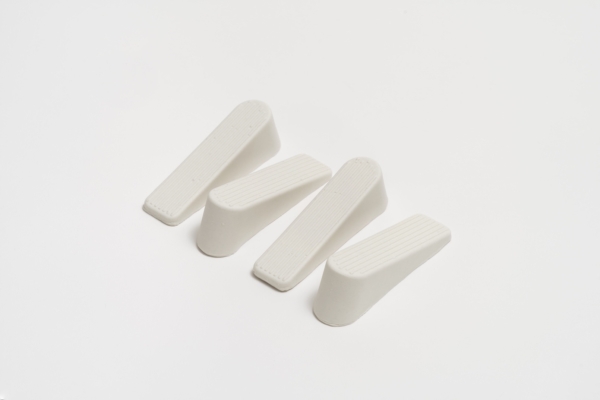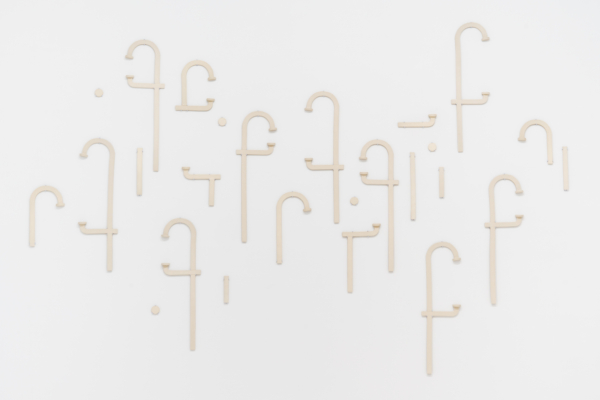formes
OPENING: Thursday January 16, 5:30 pm
ARTIST TALK: Saturday February 22, 1:30 pm
ABOUT THE EXHIBITION
While the study of materiality and the traces of process have fuelled Chloé Desjardins’ work for a number of years, in her exhibition called formes, this is expressed in a shift of the represented object, making a change from being utilitarian to becoming an artwork.
When Chloé Desjardins reproduces packaging, tools, raw materials, furniture and architectural elements, she makes visible the production context and the structures for presenting artworks, which are usually hidden or inaccessible. For the exhibition, she turned her attention to elements that have the function of holding, retaining or maintaining an object. Their purpose? To exert a tensile force that prevents any movement or change, but also rendering something static or fixed. These are clamps, hinges, door wedges and electrical insulators. Although the first two have been patiently shaped by hand, the other two have been cast. Because they are made of porcelain, the works disturb the perception we have of the materials. In the artist’s work, the fragility and delicacy of porcelain interferes with the strength and solidity of the object represented.
There’s no denying that the meaning of these objects borders on the seemingly anecdotal: some are easily forgotten because they are outdated, others, so commonplace, are at the point of invisibility. Moreover, the physical treatment of the works is all the more important because it accentuates the “forgotten” aspect of the object, or the invisible nature of the process. Indeed, the clay used is not coloured. It has a natural grayish whiteness, evoking the colour of concrete, gypsum board cement, plaster and so on. At the same time, the colour has a spectral effect that calls for the evanescence, not of the object, but of its utilitarian function. Then disappearance gives way to appearance. The object is multiplied; in the plural, it gives rise to a motif, a sequence, a landscape. These four landscapes of sculpture grace the walls of the gallery, in a rigorous arrangement. More precisely, we see they are bas-reliefs, not of traditional ornamentation or iconography, but of production objects.
The absurdity of the situation, undeniably ironic, is obvious. This shows just how much the artist enjoys playing with contradictions. In addition to the bas-reliefs, new walls modify the space. These are not made of gypsum, but of cardboard. What could be more paradoxical than to play on the porous boundaries between the fragile and the solid, the ephemeral and the permanent! The artist has created almost minimalist, visual poetry.
Looking at the exhibition overall, there is an abstraction of both the form and the identity of the objects that places us in a zone of uncertainty and makes us slow down. As a result, Chloé Desjardins presents us with a space to think about the personal and symbolic value of objects and their evocative potential in a narrative of contrasts.
-Text by Émilie Granjon
Artist biography
For the past twelve years, Chloé Desjardins has been exploring the relationship between everyday objects and works of art through sculpture and installation. She holds a Master’s degree in creation from UQAM’s School of Visual and Media Arts. During this training, she developed a keen interest in casting techniques, which still play a predominant role in her work. Her work has been exhibited in several Quebec and Canadian cities. Recipient of numerous grants from the Conseil des arts et lettres du Québec and the Canada Council for the Arts, Chloé Desjardins is the winner of the Bourse Plein sud 2014. Her work is part of the collections of the cities of Montreal, Laval and Longueuil, as well as those of the Musée des beaux-arts de Québec and the Musée d’art de Joliette. One of her sculptures is permanently installed at the Jolicoeur metro station in Montreal. Chloé Desjardins is also President of the Board of Directors of artist-run center Galerie B-312 and a teacher at Cégep du Vieux-Montréal.
Author biography
Émilie Granjon holds a DESS in Cultural Organization Management from HEC Montréal, which she obtained in 2015, and has been running the CIRCA Art Actuel artist-run center since May 2016. She is also an essayist and art critic, as well as an independent curator. With a PhD in semiology from UQAM in 2008, she analyzes the cultural issues of current art through the study of unusual figures. In her thesis, she focused on the semiogenesis of alchemical symbolism in Atalanta fugiens (1617), and published Comprendre la symbolique alchimique (PUL: Québec, 2012). In contemporary art, she co-authored with Fabienne Claire Caland Cinq fabricants d’univers dans l’art actuel (Nota Bene: Montréal, 2017) and, more recently, also with Véronique La Perrière M. Le miroir, la métaphore et le temps inversé (Sagamie: Alma, 2020).




